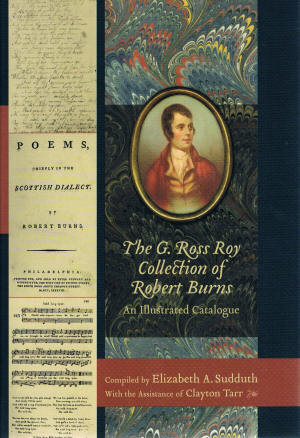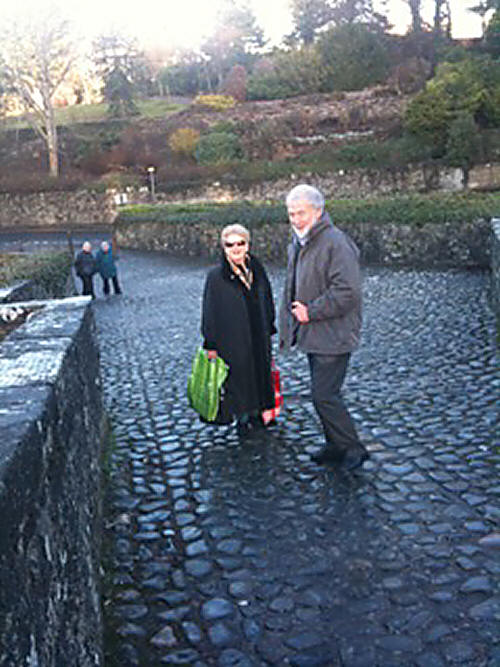|
Edited
by Frank R. Shaw, FSA Scot, Dawsonville, GA, USA
Email:
jurascot@earthlink.net
It
has been much too long since the writings of Dr. Kenneth Simpson have graced
these pages. One of the kindest and most polite men I have ever known, an
undisputed Burns scholar, as well as a talented writer, scholar, author and
speaker, it is wonderful to welcome my good friend back to Robert Burns
Lives!. Among my favorite books written on Burns are two edited by Ken:
Love & Liberty and Burns Now.
In
this article Ken reviews The G. Ross Roy Collection of Robert Burns: An
Illustrated Catalogue which first appeared in the
Scottish Literary Review edited by Sarah Dunnigan and Rhona Brown who
edits the reviews section. Thanks to them for allowing the review to appear
on our web site.
By
way of introduction to Ken’s review below, I take great pride in sharing a
blurb I was asked to write for this book:
“This eagerly awaited publication will be a joy for all serious Burnsians
since there has been no major Burns catalogue in recent times. It is a
useful research tool by the world’s most preeminent Burns scholar. Ross
Roy’s comments and illustrations regarding the rarer items make this great
collection even better for all who wish to study the Scottish bard. This
book will be of special value as a guide to the major Burns collection in
North America.” (FRS: 5.25.11)
Book Review
By Dr. Kenneth Simpson
of
The G. Ross Roy Collection of Robert Burns: An Illustrated Catalogue
Compiled by Elizabeth A. Sudduth With the assistance of Clayton Tarr
Introduction by G. Ross Roy
Foreword by Thomas F. McNally
Published by The University of South Carolina Press
in cooperation with the Thomas Cooper Library, University of South Carolina,
2009

Arguably pride of place in the G. Ross Roy Collection should go to the
edition of Burns inscribed ‘from his friend, Charlotte A. Sprigings, Xmas
1890’ to W. Ormiston Roy. The gift exchanged between Professor Roy’s
paternal grandparents initiated the collection begun by W. Ormiston Roy and
greatly enlarged by his grandson, so that it now forms the most extensive
collection of Scottish books and manuscripts outwith Scotland. The Burns
material here catalogued comprises a third of the collection.
In
his Introduction Dr. Roy acknowledges that since the publication in 1964 of
J.W. Egerer’s Bibliography of Robert Burns he has been ‘on a chase to
obtain a copy of every volume listed’. Few have eluded him. This Burns
cornucopia includes Kilmarnock and Edinburgh editions; one of only two known
copies of The Merry Muses of Caledonia (1799) – ‘by far the most
important eighteenth-century volume in the collection’ in Roy’s view; a
wealth of songbooks and chapbooks; several interesting Burns letters; a
Miers silhouette of Clarinda with a lock of her hair; and items such as a
recording of J. Ramsay MacDonald, ‘Robert Burns, a Man Amongst Men’, the
1937 movie, Auld Lang Syne with Andrew Cruikshank as the Bard, and
Burns’s porridge-bowl and spoon. Courtesy of the W.Ormiston Roy Research
Fellowship, scholars have been afforded access to such materials; and the
University of S. Carolina has a distinguished record in hosting
international conferences on Scottish literature. Rightly Thomas F. McNally
in his Foreword claims for the University’s Thomas Cooper Library ‘a
distinctive research strength in Scottish literature…unrivalled in North
America’; and, since the catalogue is now online, access is available to
all.
Appropriately published in 2009, this illustrated catalogue is the most
valuable of the many Burns books of that year. This is a book to be read,
rather than merely consulted: it opens up so many roads to, and from, Burns.
The chronological order of publication in the first two sections –
‘Manuscripts and Typescripts’ and ‘Printed Materials, Books, and Sheet Music
by Burns’ - fosters awareness of movements in taste, fluctuations in Burns’s
reputation, and – above all – publishing history. For selected major items
Roy offers informative annotations: the expansion of the five-page glossary
of the Kilmarnock edition to twenty-five pages in the Edinburgh indicates
the ever-increasing range of Burns’s readership; it is helpful to be
reminded that ‘Holy Willie’s Prayer’ first appeared in a chapbook in 1789;
and a promissory note by Burns shows that ‘in late eighteenth-century small
towns, handwritten drafts and IOU’s substituted for more formal banking’,
hence some of the poet’s financial problems are contextualised.
Inscribed editions of Moore’s Zeluco, Thomson’s The Seasons,
and Cumberland’s The Observer reflect Burns’s range of reading; and
marginalia testify to his boast in a letter, ‘I would not give a farthing
for a book, unless I were at liberty to blot it with my criticisms’. Various
items give insight into Burns’s methods of composition and the contexts
thereof: on the manuscript of ‘Lesley Bailie: A Scots Ballad’ the poet
writes, ‘the foregoing Ballad was composed as I galloped from Cummertrees to
town, after spending the day with the family of Mayfield’ (surely there is a
thesis to be written on Burns’s trotting, cantering, and galloping poetic
rhythms?); a poem to Syme is written at the ‘Jerusalem Tavern, Dumfries,
Monday even’; and – a wonderful irony which Burns must have relished – ‘An
Address to the Unco Guid’ is inscribed on the endpapers of a published
sermon, Thomas Randall’s Christian Benevolence.
Some of the biographical issues which currently preoccupy Burnsians are
represented. Was Burns serious about emigration? Burns’s farewell letter –
‘my last this side of the Atlantic’ - to Thomas Campbell, August 19, 1786,
might seem to settle the matter until one realises that it predates both
Jean Armour’s giving birth to twins and Thomas Blacklock’s recommending a
second, enlarged edition of the poet’s work. There is material aplenty
relating to the Edinburgh sojourns, influential in a variety of ways on the
poet’s career: a newly recovered letter from Clarinda speaks for Burns’s
personal life; proof-sheets of ‘Tam o’ Shanter’ with Alexander Fraser
Tytler’s marginal emendations betoken the influence of the literati. Burns’s
life is here contextualised in the context of his age and its values. The
contemporary concern with the relationships between primitive and modern
societies and cultures is typified in Tytler’s translation for Burns of part
of Lucan’s Pharsalia concerning the Druids and human sacrifice; and
the poet as Man of Feeling is revealed by what appears to be the shedding of
the requisite single tear upon a letter to Clarinda.

Susan Shaw and
Ken Simpson walking in Dumfries
The catalogue also provides a useful index both to Burns’s popularity and to
the ways in which he came to be viewed and used. It is comforting to know
that for those for whom the cost of a Kilmarnock or Edinburgh edition was
prohibitive there was still access to Burns through chapbooks. It is
salutary to note that ‘To a Mountain Daisy’, a poem little in favour now,
was included in 1794 in The Young Gentleman and Lady’s Poetical Preceptor:
Being a collection of the most admired poetry selected from the
best authors. Similarly, the frequency of nineteenth-century printings
of ‘The Cotter’s Saturday Night’ attests to the selectively didactic use of
Burns. An edition of Burns’s Works is inscribed, ‘Marmaduke Head Best
with the best wishes of Robert Sheppard Routh, On his leaving Eton, Easter
1864’; Logie Robertson’s edition, Selected Poems (1889) bears the
bookplate of Edinburgh Ladies College; and Valentine & Sons printing of ‘Tam
o’ Shanter’ (189-?), complete with original tartan covers, is inscribed
‘with best wishes from Aunt Jeannie’. That Burns came to be identified with
‘Scottishness’ is variously testified: Burns is anthologised in Heather
Bells (London; Paris, New York: Raphael Tuck & Sons [ca. 1900]) with a
frontispiece, ‘The Bairn’s Breakfast’ by H.J. Dobson; in Glasgow and New
York in 1903 appeared Guid Bits frae Robert Burns. Witty, humorous,
serious, pathetic & pithy; and a presentation copy of ‘The Cotter’s
Saturday Night’ to Sir Harry Lauder has two poems inscribed on the
preliminaries – ‘In Robbie Burns o’ deathless fame’ and ‘Address to Harry
Lauder’. As counter to couthiness the various translations – Russian,
Japanese, Portuguese, Gaelic, and others – indicate that Burns reaches all
corners of the globe. The many whom he inspired include Robert Tannahill,
with whose songs Burns’s were often reprinted; the freed slave, Frederick
Douglass; the artists, John Faed and Thomas Landseer; and the poet and
dramatist, Tom Wright, whose play, There Was a Man, did so much to
further popularise Burns in the nineteen-sixties and seventies.
Materials vital to Burns scholarship abound in this collection – five
letters from Cromek to Creech in 1808; Agnes McLehose’s letter to Cunningham
reiterating the embargo on access to Burns’s letters to her; Isabella Burns
Begg’s letter referring to Jean Armour in unflattering terms; and the
research manuscripts of major Burns scholars such as J. DeLancey Ferguson,
Robert H. Thornton, and G. Ross Roy.
As well as enlightenment, this catalogue offers entertaining
moments. Celebration of the 111th
Anniversary of Robert Burns’ Natal day, at Delmonico’s Hotel, New York,
January 25th,
1870 sounds promising; one longs to have been in the audience when the
‘Eastern-Empire Lyceum Bureau present[ed] The Scottish Musical Comedy
Company in an Original Adaptation of Robert Burns’ “The Cottar’s Saturday
Night”’; and James Findlay, Burns in Heaven: Suggested When Looking at
Burns’ Statue, Union Terrace, Aberdeen (1908) tantalises.
Elizabeth A. Sudduth is to be warmly congratulated and thanked. This book is
a Herculean achievement, the result of what must often have seemed a
Sisyphean endeavour. The catalogue records the contents of this outstanding
collection to July 2008. Dr Roy writes that he continues ‘scouring dealers’
catalogues and the Internet for more titles’. Charlotte A. Sprigings
certainly started something! |
